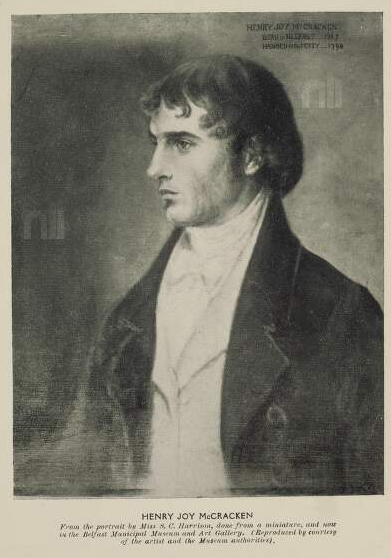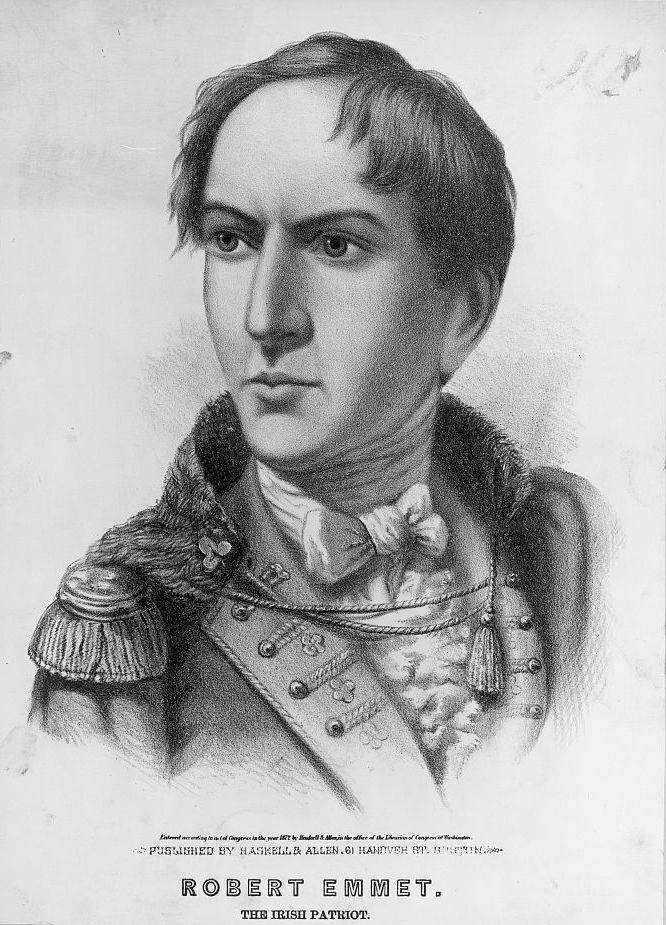Notable Prisoners
Henry Joy McCracken
31 August 1767 – 17 July 1798
In Kilmainham Gaol: October 1796 – December 1797
Born in Belfast to a prominent Protestant industrialist family, Henry Joy McCracken joined the Society of the United Irishmen in his late twenties. He was arrested for activity within the Society in October 1796, and incarcerated in Kilmainham Gaol. He was released on bail a year later, partly due to severe illness. He recovered, and resumed working with the Society, particularly leading up to the Rebellion of 1798. For his leadership role in the Rebellion in Antrim, he was court-martialled in Belfast, and sentenced to death. He was hanged in July of 1798, at the age of thirty.
Robert Emmet
4 March 1778 – 20 September 1803
In Kilmainham: c.26 August 1803 – 20 September 1803
Robert Emmet was the son of a wealthy Dublin Protestant family who resided on St Stephen’s Green. His father sympathised with the lack of representation of Catholics in Parliament, and his older brother Thomas was close friends with founder member of the Society of the United Irishmen, Wolfe Tone. Emmet was expelled from Trinity College Dublin as a student in early 1798 as a result of his membership of a secret United Irishmen group on campus. Fleeing to France to escape arrest, he won an audience with Napoleon, who promised him and the United Irishmen support.
After the failed 1798 Uprising, he reorganised the defeated Society. After the loss of French support in the following years, Emmet began to plan a new rebellion, with fellow revolutionaries James Hope and Thomas Russell. Weapons were manufactured in secret, and a proclamation written, with 10,000 copies of it printed. Beset by problems, on 23rd July 1803, the rebellion nevertheless went ahead in Dublin. With the rebellion quickly quelled, Emmet went into hiding. He was captured while attempting to meet his fiancée, Sarah Curran, and detained at Kilmainham. On the 19th of September, he was found guilty of high treason. This was the day he delivered his famous Speech from the Dock, which would go on to inspire generations of nationalists after him. The following day, he was executed on Thomas St, and his beheaded body taken back to Kilmainham Gaol. He was twenty-five years old. Instructions were to bury him in the graveyard closest to Kilmainham Gaol, known as Bully’s Acre, but the location of his body has remained a mystery since.
While in Kilmainham, Emmet wrote to his fiancée Sarah Curran, and this love letter became famous in the Victorian period, earning Emmet the reputation of a romantic.
Robert Emmet
4 March 1778 – 20 September 1803
In Kilmainham: c.26 August 1803 – 20 September 1803
Robert Emmet was the son of a wealthy Dublin Protestant family who resided on St Stephen’s Green. His father sympathised with the lack of representation of Catholics in Parliament, and his older brother Thomas was close friends with founder member of the Society of the United Irishmen, Wolfe Tone. Emmet was expelled from Trinity College Dublin as a student in early 1798 as a result of his membership of a secret United Irishmen group on campus. Fleeing to France to escape arrest, he won an audience with Napoleon, who promised him and the United Irishmen support.
After the failed 1798 Uprising, he reorganised the defeated Society. After the loss of French support in the following years, Emmet began to plan a new rebellion, with fellow revolutionaries James Hope and Thomas Russell. Weapons were manufactured in secret, and a proclamation written, with 10,000 copies of it printed. Beset by problems, on 23rd July 1803, the rebellion nevertheless went ahead in Dublin. With the rebellion quickly quelled, Emmet went into hiding. He was captured while attempting to meet his fiancée, Sarah Curran, and detained at Kilmainham. On the 19th of September, he was found guilty of high treason. This was the day he delivered his famous Speech from the Dock, which would go on to inspire generations of nationalists after him. The following day, he was executed on Thomas St, and his beheaded body taken back to Kilmainham Gaol. He was twenty-five years old. Instructions were to bury him in the graveyard closest to Kilmainham Gaol, known as Bully’s Acre, but the location of his body has remained a mystery since.
While in Kilmainham, Emmet wrote to his fiancée Sarah Curran, and this love letter became famous in the Victorian period, earning Emmet the reputation of a romantic.


